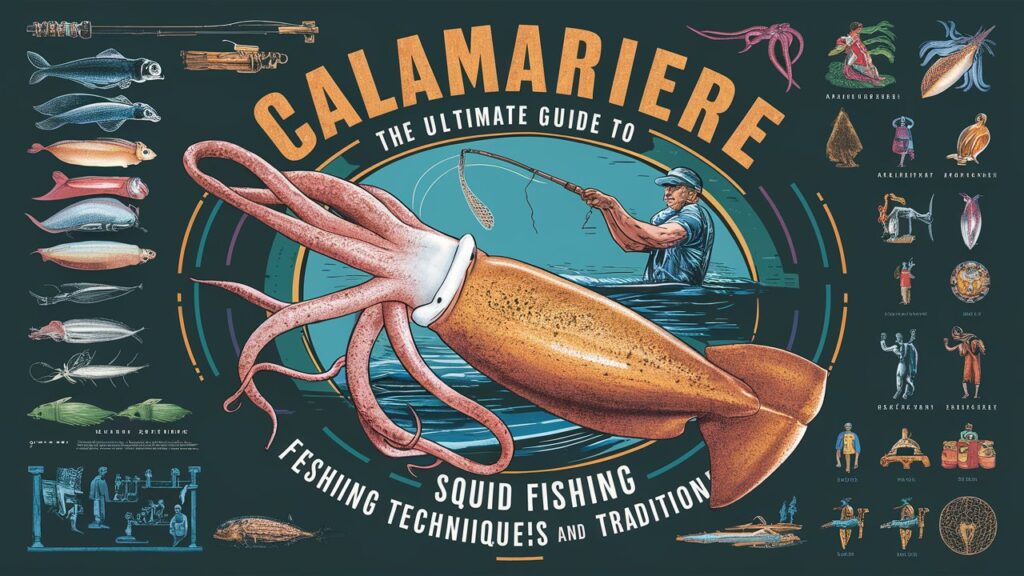Squid fishing, known as “calamariere” in Italian, is an age-old tradition deeply rooted in Mediterranean culture. Whether carried out by small-scale fishermen or large commercial fleets, squid fishing remains a vital industry, providing fresh seafood to markets worldwide. This guide explores the techniques, history, and modern practices of calamariere, offering insights for both fishing enthusiasts and those curious about sustainable seafood.
From traditional hand-jigging methods to advanced fishing boat technologies, calamariere has evolved while retaining its cultural significance. We’ll also dive into the best fishing spots, regulations, and how calamariere-caught squid makes its way to gourmet dishes.
The History and Cultural Significance of Calamariere
Squid fishing has been a staple in Mediterranean coastal communities for centuries. The term “calamariere” refers not only to the practice of catching squid but also to the specialized boats designed for this purpose. Historically, fishermen used simple nets and wooden boats, relying on moonlit nights when squid are most active.
In Italy, Spain, and Greece, calamariere fishing is more than just an industry—it’s a tradition passed down through generations. Festivals celebrating squid, such as Italy’s Sagra del Calamaro, highlight the cultural importance of this seafood. The methods have modernized, but the essence of calamariere remains tied to the rhythms of the sea.
Modern Calamariere Techniques: How Squid Fishing Works Today
Today, squid fishing employs a mix of traditional and high-tech methods. The most common techniques include:
-
Jigging: Using luminous lures to attract squid, often done manually at night.
-
Trawling: Larger boats use specialized nets to catch squid in deeper waters.
-
LED Light Fishing: Many modern calamariere boats use bright underwater LEDs to lure squid, increasing catch efficiency.
Commercial calamariere fleets operate primarily in the Mediterranean, Atlantic, and Pacific, supplying global demand for calamari. However, concerns about overfishing have led to stricter regulations, pushing the industry toward sustainability.
Best Calamariere Fishing Spots in the World
The Mediterranean remains the heart of squid fishing, with key locations including:
-
Sicily, Italy: Known for its rich squid populations and traditional fishing villages.
-
Aegean Sea, Greece: A hotspot for both small-scale and commercial squid fishing.
-
Japan & South Korea: Leading in high-tech squid fishing methods.
-
California Coast, USA: A growing region for sustainable squid harvesting.
Each region has its peak seasons, with late summer and autumn being the most productive times for calamariere fishing.
Sustainable Calamariere: Balancing Harvest and Conservation
With increasing demand for squid, sustainable fishing practices are crucial. Overfishing and bycatch (accidental capture of other marine life) are major concerns. Some solutions include:
-
Regulated Fishing Seasons: Preventing overharvesting during breeding periods.
-
Eco-Friendly Gear: Using selective nets to reduce bycatch.
-
Marine Stewardship Council (MSC) Certification: Ensuring squid is sourced responsibly.
Consumers can support sustainability by choosing MSC-certified calamari and asking about sourcing when dining out.
From Sea to Table: How Calamariere Squid Enhances Global Cuisine
Squid caught through calamariere methods is prized for its freshness and texture. It’s a staple in dishes like:
-
Italian Calamari Fritti: Lightly fried squid rings, a classic appetizer.
-
Greek Grilled Calamari: Seasoned with olive oil, lemon, and herbs.
-
Japanese Ika Sashimi: Fresh squid served raw with soy sauce and wasabi.
The journey from boat to plate ensures high quality, making calamariere squid a favorite among chefs and seafood lovers.
Conclusion
Calamariere is more than just squid fishing—it’s a blend of tradition, innovation, and sustainability. From the moonlit jigging techniques of old to today’s LED-equipped trawlers, the industry continues to evolve while preserving its cultural roots. Whether you’re a fisherman, a seafood enthusiast, or an eco-conscious consumer, understanding calamariere helps appreciate the effort behind every plate of calamari.
By supporting sustainable practices and exploring the best fishing spots, we can ensure that calamariere remains a thriving tradition for generations to come.
FAQ About Calamariere
1. What does “calamariere” mean?
“Calamariere” is an Italian term referring to squid fishing or the boats used for catching squid.
2. What is the best season for squid fishing?
Peak squid fishing seasons vary by region but often occur in late summer and autumn when squid are most active.
3. Are there eco-friendly calamariere methods?
Yes, sustainable practices include regulated fishing seasons, selective nets, and MSC-certified fishing operations.
4. Which countries are known for calamariere fishing?
Italy, Greece, Spain, Japan, and the USA (California) are leading regions for squid fishing.
5. How is calamariere squid different from other squid?
Calamariere-caught squid is often fresher and prized for its texture, making it ideal for gourmet dishes.

